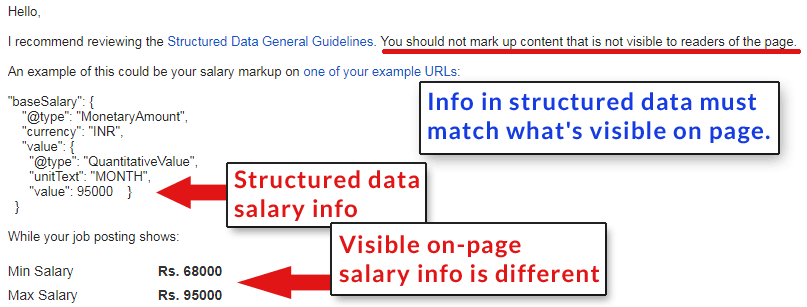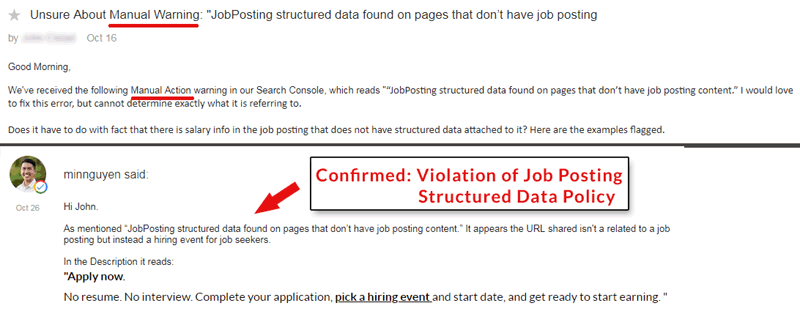Adding structured data is always a good idea. However, an incorrect implementation can lead to a manual action. A loss of rankings is a high price to pay for not paying attention to details.
Structured Data Spam is real. Google even has a support page devoted specifically to it.
The sad thing about structured data penalties is that they can happen by a simple misunderstanding or by charging into it without stopping to read Google’s guidelines. Spam penalties (also known as manual actions) can happen when there is no intent to spam. A mistake will still be seen as spam.
This is why it’s important to know how things can go wrong in order to not repeat the mistakes others have made.
A review of the webmaster help forums turned up a number of common mistakes that lead publishers to ask for help.
Here are five common structured data mistakes:
- Using inappropriate structured data
- Structured data doesn’t match on-page content
- Violates Google’s Guidelines for a specific data type
- Violates Google’s Structured Data General Guidelines
- Shortcuts and taking liberties (aka manipulative behavior)
1. Using inappropriate structured data
This is the kind of thing that can happen when not making the right choice for structured data. For example, using structured data designed for a Product when the company is offering a service. Something as seemingly trivial as this can result in a manual penalty from Google.
 Screenshot of a post in Google’s Webmaster Help forums. A member was penalized for using the wrong structured data type.
Screenshot of a post in Google’s Webmaster Help forums. A member was penalized for using the wrong structured data type.2. Structured data must match what’s on page
Whatever information is used, like prices, it must be reflected exactly the same in the on page content that’s visible to users. In the example below, a job posting site listed a salary range to site visitors but a different salary in the structured data.
 The structured data did not match what was on the web page.
The structured data did not match what was on the web page.3. Failure to Read Developer Pages for Specific Data Types
Failure to read and follow the guidelines for specific data types can lead to a variety of errors. Those errors can result in a manual penalty.
It’s very important to double check the examples on Google’s developer pages for what is and what is not appropriate. Five minutes of your time reading the guidelines can save you weeks of being penalized.
There are currently 20 Developer Pages for the following content types:
- Article
- Book
- Course
- Dataset
- Employer Aggregate
- Event
- Fact Check
- Job Posting
- Local Business
- Media (restricted)
- Occupation
- Paywalled content
- Podcast
- Product
- Recipe
- Review
- Software App (beta)
- Speakable (beta)
- Top Places List (beta)
- Video
4. Failure to Review Structured Data General Guidelines
In addition to the guidelines related to specific data types, Google has also published guidelines that cover all use of structured data. It’s important to have a good understanding of these general policies in order to avoid penalization.
An important note: Just because the structured data validates in Google’s Structured Data Testing Tool, it doesn’t mean it’s correct.
Familiarize yourself with Google’s General Structured Data Guidelines. The importance of understanding those guidelines cannot be overstated.
 Just because your structured data validates does not mean that it doesn’t violate Google’s guidelines.
Just because your structured data validates does not mean that it doesn’t violate Google’s guidelines.
5. Taking Shortcuts aka Manipulative Behavior
The example below is of a website that did not have a job offer but still used the Job Posting structured data. This is manipulative behavior designed to attract users from Google’s search results to a page that does not offer what’s in the structured data.

I asked Structured Data expert Casey Markee of MediaWyse about common mistakes he has seen.
Casey offered the following valuable insights:
The biggest mistake I see is hiding schema off the page. For example hiding aggregate reviews or stars but showing them as marked up.
That’s a no-no.
And it’s important to note as well that QUALITY plays a huge role in the loss of rich snippets but you don’t always trigger a manual notice.
The most common example of this I see is when you have a popular page with lots of structured data that suddenly loses all their visible rich snippets in the SERPs.
The most common reason this happens is because the page has accumulated hundreds of comments and the page speed goes off a cliff!
I just go in, paginate or lazy load the comments and BOOM, the rich snippets come back. In hours usually.
So in those cases it feels like a penalty and you lose traffic but Google doesn’t send out a notice“
That’s great advice and good insights! Do your research. Read all the guidelines. Don’t allow the Structured Data Testing Tool to lull you into a false sense that everything is fine. If you avoid these five mistakes then you should be on your way to success with Schema.org Structured Data.
More Resources
Images by Shutterstock, Modified by Author
Screenshots by Author
Subscribe to SEJ
Get our daily newsletter from SEJ’s Founder Loren Baker about the latest news in the industry!
